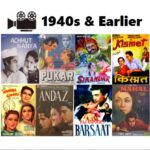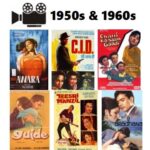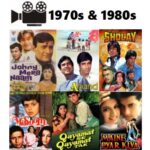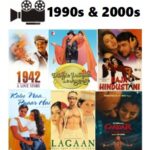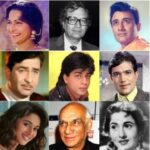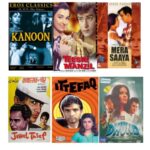Clicking on the following links or images will take you to the Hindi movie collections covered in this section:
Note: Click here to go to the Blogs, Posts & Forum section on Hindi movies.
In this section, I have compiled a list of my favorite Hindi movies for each decade starting from the 1940s (the list actually includes a couple of movies from the 1930s!). I have also marked with a GEM symbol those movies I consider the “best of the best” (GEM = Genuine Masterpiece). Of course, these selections are entirely subjective, but as I have found that my tastes match quite well with a majority of people I am sure most of you will find these movies to be enjoyable as well. If you have any suggestions on additions or deletions, please share them using the Comments/Suggestions form.
I have segmented the movie lists by the decades in which the movies were released. In addition, I have identified a set of standout actors, actresses, producers and directors whom I consider to be luminaries, and I have compiled specific lists of their respective bodies of work. Since I have always been a fan of thrillers, I have also created a special list of Hindi movies in this category. Next, there are some memorable roles by performers who will always be identified with those roles, and I have made a list of those as well, again based on my own (subjective) judgment. Finally, I have made a list of top films based on two separate criteria: (a) movies I have classified as GEMs based on my personal criteria, and (b) movies which won the Filmfare awards for best film, best director, best actor or best actress.
A Brief History of Hindi Movies
In this section, I would like to share my perspective on the different phases of the development of Hindi films, from the 1930s to the present day. In my view, the evolution of Hindi films can be divided into five different eras, which parallel the evolution of Hindi film music (covered in a different section):
(a) Pre-1949: Studio Era. Most movies during this period were produced by a handful of studio companies (such as Bombay Talkies, Sagar Movietone and Filmistan) which employed actors, directors and music artistes on a salary under contract. This period also marked the emergence of Bombay as the center of virtually all Hindi film production.
(b) 1949-1980: Golden Age. This was truly the golden period for both Hindi films and Hindi music, during which a large number of talented producers, directors and actors/actresses emerged and quickly established themselves. Moviegoers flocked to the theaters simply based on which actors were in the star cast or which producer/director had made the movie. (More details about these stars and movie-makers can be found in the Hindi Film Luminaries section.) The talent and creativity of the industry during these three decades were at their absolute peak, and a staggering body of work was created during this period which will never be surpassed.
(c) 1981-1989: Transition Period. In contrast to the preceding period, the 1980s represented the low point for Hindi films, as many of the giants of the industry had passed away, retired or reached the sunset of their careers. The replacements did not come close to having the same caliber, and thus their creations were passable at best. (During this period, the Hindi film industry became better known as “Bollywood,” which until then had been more of a pejorative nickname.)
(d) 1990-2005: Revival Period. This period marked the advent of modern Hindi films, which were much more glossy and had slicker production values than those of the Golden Age. Most of the old guard was gone, but new talent emerged to take its place, such as the three Khans (Shah Rukh, Salman and Aamir). The quality of the movies also took a step up, and this period, which lasted for 15 years, revived a similar creative atmosphere to what was prevalent in the Golden Age.
(e) 2006-Present: Modern Bollywood. Starting in the mid-2000s, Hindi films became more of a corporate business akin to the way things are in Hollywood. Multiplexes started to sprout all over India, while the overseas market for Indian films became larger than the Indian market. With the proliferation of smart phones and high-speed streaming, the primary means of distribution of Hindi films moved from DVDs to the internet. While there is certainly an audience for this new style of movie-making, there is very little resemblance to the Hindi films created in the latter half of the twentieth century.

